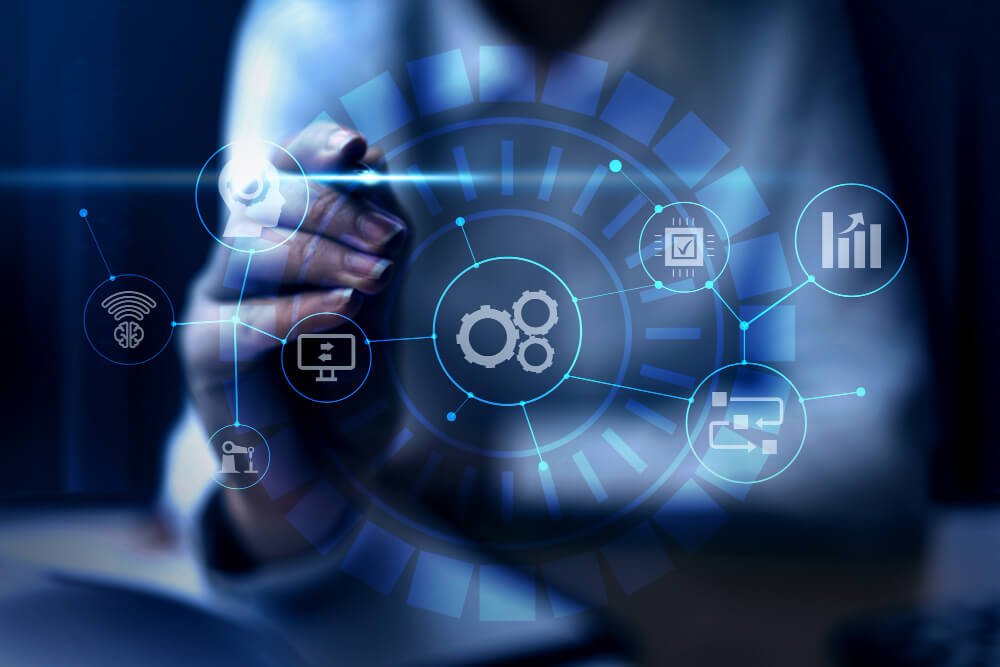Introduction:
Have you ever wondered how AI Technology and IoT are shaping the future of technology? In today’s digital age, the fusion of artificial intelligence (AI) and the Internet of Things (IoT) is sparking a technological revolution, poised to transform industries worldwide. This dynamic duo promises to not only boost efficiency but also foster innovation at an unprecedented rate.
To grasp the significance of this convergence, let’s break it down. IoT revolves around a vast network of interconnected devices embedded with sensors. These devices gather and transmit extensive data, which is then analyzed to make informed decisions based on user behavior and patterns.
Meanwhile, AI serves as the brains behind the operation. It mimics human intelligence and behavior within computer systems, continuously learning and adapting to develop new skills and behaviors.
Together, these technologies have the potential to tackle real-world challenges and usher in a new era of product development, enhancing the digital experience for customers and businesses alike. In this article, we’ll explore the myriad opportunities and strategies at the intersection of AI and IoT, promising to revolutionize market dynamics and inspire innovation. Join us as we unravel the exciting possibilities awaiting developers in this rapidly evolving landscape.
Read also Become an AI Expert With These Free Online Courses
The Interconnection Between IoT and AI Technology
In today’s business landscape, digital transformation is no longer just a buzzword—it’s a strategic imperative. According to a recent study by the IBM Global C-Suite Study program, executives at the highest levels are recognizing the need to embrace technology to stay competitive. One of the key areas they’re honing in on is the intersection of AI and IoT.
If you’re a business leader aiming to drive growth and innovation, understanding the synergy between AI and IoT is essential. This powerful combination isn’t just about optimizing operations; it’s about revolutionizing the way we deliver products and services to customers.
Take, for instance, the rise of voice-enabled smart assistants like Google Home and Amazon’s Alexa. These devices seamlessly integrate AI capabilities with IoT functionality, creating personalized, intuitive experiences for users.
What’s more, both established players and agile startups are recognizing the potential of this fusion. Companies like Amazon, Salesforce, Microsoft, and Oracle are investing heavily in developing IoT platforms infused with AI intelligence. This strategic move allows businesses to leverage vast amounts of data generated by IoT devices to drive insights, optimize processes, and ultimately, deliver superior customer experiences.
In essence, the marriage of AI and IoT isn’t just a trend—it’s a game-changer for businesses looking to stay ahead in today’s fast-paced digital landscape.
Understanding of Sensors, Motors, and Robotics
Understanding sensors, motors, and robotics is like having a superpower in today’s tech-driven world. For IT engineers and IoT developers, these skills are like the building blocks of innovation, opening doors to a world of wireless communication systems, embedded logic, and endless possibilities.
Let’s start with sensors—the unsung heroes of the digital age. These little wonders have the incredible ability to detect everything from temperature and light to sound waves and humidity. They’re like the eyes and ears of IoT devices, helping them make sense of the world around them.
When it comes to robotics, it’s all about mastering the art of data. IT engineers and developers need to know the ins and outs of data collection, processing, and storage to train and develop robots effectively. Think of it as teaching a new language to these mechanical marvels—they need to understand and interpret the world just like we do.
To equip themselves for this exciting journey, IT engineers and IoT developers need the right tools in their arsenal. From analysis tools like Python’s Pandas and NumPy libraries to robotics hardware like motors, sensors, and actuators, they need to be familiar with the latest technologies. And let’s not forget about software frameworks like Robot Operating System (ROS) and popular robotics platforms such as Arduino and Raspberry Pi—they’re the backbone of any robotics project.
In a nutshell, mastering sensors, motors, and robotics isn’t just about learning a set of skills—it’s about unlocking the potential to shape the future of technology. So, if you’re ready to embark on this thrilling adventure, buckle up and get ready to explore the exciting world of IT engineering and IoT development.
Artificial Intelligence and Machine Learning
Artificial Intelligence (AI) and machine learning (ML) are like the dynamic duo transforming the IT landscape. For IT engineers and IoT developers, mastering these technologies isn’t just a bonus—it’s a must-have skill set in today’s tech-driven world.
Think of AI and ML as the engines powering the next generation of IoT devices and AI applications. From smart appliances to cutting-edge solutions in automotive, manufacturing, finance, and healthcare, the possibilities are endless. But to harness their full potential, you need to understand where and how to apply ML algorithms, especially with the help of data sensors.
One crucial skill in this realm is big data management. It’s like having a treasure map to unlock valuable insights hidden within vast amounts of data. By identifying patterns and trends, predictive analytics becomes possible, paving the way for smarter decision-making and innovative solutions.
But it’s not just about knowing the theory—you need the practical skills too. Familiarity with popular ML libraries like Keras and TensorFlow is essential, as is proficiency in programming languages like R, Python, and C++. These tools are like your Swiss army knife in the world of AI and ML, enabling you to turn ideas into reality and push the boundaries of what’s possible.
So, whether you’re an aspiring IT engineer or an IoT developer looking to stay ahead of the curve, mastering AI and ML is your ticket to success in the ever-evolving tech landscape. With the right skills and knowledge, you’ll be ready to tackle any challenge and unlock the full potential of these groundbreaking technologies.
IoT Systems and Networking
Picture this: a world where everyday objects—from motion sensors to smart glasses—are not just passive tools but interconnected devices, communicating seamlessly over the internet. Welcome to the Internet of Things (IoT), a burgeoning field at the heart of the IT industry.
To truly master IoT, IT engineers and developers need to grasp its core concepts and technologies. It’s not just about connecting devices; it’s about creating robust, seamless experiences for users. This requires a deep understanding of networking protocols like Bluetooth, Zigbee, and Wi-Fi—the invisible highways that enable devices to communicate with each other and the internet.
But it’s not all about the tech. To excel in IoT development, professionals need more than just coding skills—they need a knack for user interface (UI) design. This means knowing how to create intuitive, visually appealing interfaces that make interacting with IoT devices a breeze. From visual design to analytics, wireframing, and prototyping, UI skills are essential for developing devices that users love.
And let’s not forget about IoT platforms like AWS IoT and Microsoft Azure. These platforms provide the infrastructure and tools needed to build, deploy, and manage IoT applications at scale. Familiarity with these platforms is like having a secret weapon in your toolkit, empowering you to bring your IoT projects to life with ease.
In a nutshell, mastering IoT systems and networking isn’t just about understanding the tech—it’s about creating meaningful experiences that enhance people’s lives. So whether you’re an IT engineer or an IoT developer, dive deep into the world of IoT and unlock its full potential. The possibilities are endless, and the future is bright.
Information Security
In today’s digital landscape, information security is more critical than ever. With the proliferation of connected devices in the Internet of Things (IoT), cybersecurity professionals play a vital role in safeguarding our digital world.
Over the years, cyber attackers have caused significant harm, from hijacking critical systems to stealing sensitive data. Understanding cybersecurity practices and principles is essential for IT engineers and IoT developers alike. They need to be aware of common threats like denial-of-service (DoS) attacks and ransomware, and equipped with strategies to thwart them using communication protocols such as Transport Layer Security (TLS) and Secure Shell (SSH).
But it’s not just about defense—it’s about staying one step ahead of the game. Security engineers in the cybersecurity field must be creative and adaptable, constantly evolving their strategies to counter new threats. This means leveraging cutting-edge tools and technologies, including AI and ML security solutions from various vendors. These tools provide secure content distribution networks, helping to fortify defenses and keep sensitive information out of the wrong hands.
In essence, information security isn’t just a job—it’s a mission to protect the integrity of our digital world. By understanding the principles of cybersecurity and embracing innovative solutions, IT engineers and IoT developers can play a crucial role in building a safer, more secure internet for all.
Node.js Development
Let’s talk about Node.js—a game-changer in the world of web development. This open-source platform isn’t just about writing code; it’s about building scalable, efficient IoT applications while keeping ethics and internet safety front and center.
Node.js is like a Swiss army knife for IoT specialists. It’s the go-to tool for server-side web development, thanks to its vast array of packages and modules. Whether you’re working on firmware development or connecting system devices, Node.js has you covered. With this skill in your toolkit, you can tackle complex tasks like developing IoT devices and AI applications with ease, ensuring smooth connectivity for a multitude of devices.
Take, for example, the way Node.js facilitates communication between connected devices. Whether it’s Arduino for embedded programming interfaces or Raspberry Pi for software development using Python and Node.js, Node.js makes it seamless to bring devices together and make them work in harmony.
But it’s not just about technical prowess—soft skills are equally important. Empathy, active listening, and the ability to understand customers’ needs are essential for success in the IoT space. After all, it’s not just about writing code; it’s about creating solutions that genuinely address real-world problems and make people’s lives easier.
As we delve deeper into the world of IoT and AI, it’s clear that Node.js development skills are in high demand. Whether you’re an IT engineer or an IoT developer, mastering Node.js opens up a world of opportunities to create innovative, impactful solutions. So, if you’re ready to take your skills to the next level, Node.js is the place to start.
Conclusion: The Intersection of AI Technology and IoT
In conclusion, the convergence of AI and IoT represents a monumental shift in the technological landscape, with far-reaching implications for industries worldwide. As outlined in this article, the synergy between these two domains holds tremendous potential to drive innovation, enhance efficiency, and revolutionize the way businesses operate.
From the interconnection of IoT systems and networking to the mastery of sensors, motors, and robotics, it’s clear that the future of smart devices lies at the intersection of these technologies. Moreover, the critical role played by information security cannot be overstated, as safeguarding data and systems becomes increasingly paramount in an interconnected world.
Furthermore, the importance of Node.js development in building scalable and efficient IoT applications underscores the significance of staying abreast of emerging technologies and honing both technical and soft skills.
As we navigate this ever-evolving landscape, it’s essential for IT engineers and IoT developers to continuously adapt, innovate, and collaborate to harness the full potential of AI and IoT. By doing so, we can collectively shape a future where technology serves to enrich lives, drive progress, and create sustainable solutions for the challenges of tomorrow.

